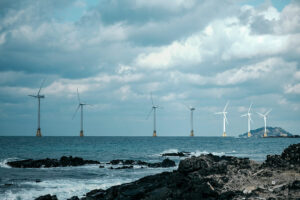DoE, DENR grant rights to access offshore areas for energy dev’t
THE GOVERNMENT is seeking to fast-track the development of offshore wind projects in the Philippines, aiming to deliver power from these by 2028 by further streamlining permit processing.

By Sheldeen Joy Talavera, Reporter
THE GOVERNMENT is seeking to fast-track the development of offshore wind projects in the Philippines, aiming to deliver power from these by 2028 by further streamlining permit processing.
The Department of Energy (DoE) and the Department of Environment and Natural Resources (DENR) signed a memorandum of agreement (MoA) on Friday last week, allowing access to offshore and auxiliary areas.
The agencies are granting rights to offshore areas covered by offshore wind energy service contracts, including auxiliary areas, to accelerate the exploration, utilization, and development of the projects, the DoE said in a statement over the weekend.
Under the agreement, developers with contracts will have access to the areas during the exploration, development, and commercial development phases of the projects, subject to necessary DENR requirements.
The DoE will provide the DENR with a list of identified offshore wind projects within 30 days after the execution of the agreement.
It noted that the list will be regularly updated, in collaboration with the DENR, to reflect new offshore wind service contracts and development activities.
The DENR has the right to impose additional conditions or deny access altogether if an area falls within an environmentally critical zone or is subject to prior vested rights, the DoE said.
“This landmark agreement streamlines the process of exploring, utilizing, and developing offshore wind projects, while ensuring that environmental safeguards are in place at every stage,” the agency said.
Under the current system, renewable energy projects are required to secure various compliances with the DENR, such as foreshore lease agreements, forest land use agreements, and miscellaneous lease agreements, before proceeding with exploration and development.
However, with the agreement, offshore wind energy service contracts now provide sufficient authority to advance these projects without needing separate agreements.
“This MoA is a crucial step in realizing the goal of the administration of President Ferdinand Marcos Jr. to deliver the first kilowatt-hours from offshore wind projects by 2028,” Energy Secretary Raphael P.M. Lotilla said.
“By streamlining the process for accessing critical areas, we are paving the way for a rapid and responsible rollout of offshore wind projects, which will contribute significantly to our clean energy transition,” he added.
While the Philippines is seizing opportunities that renewable energy can provide, DENR Secretary Maria Antonia Yulo-Loyzaga said the country “must also remain vigilant in addressing any unintended consequences on our ecosystems.”
“The exploration, development, and utilization of offshore wind resources have to be approached with care to protect our marine, terrestrial, and socio-economic environments as well,” she said in her speech.
The DoE has already awarded 92 offshore wind energy service contracts to 38 renewable energy developers with a total potential capacity of 66.101 gigawatts.
Last month, the DoE said that the Philippine Ports Authority (PPA) had initiated immediate steps to repurpose three priority ports to fulfill the operational requirements of offshore wind projects.
The DoE identified the Port of Currimao in Ilocos Norte, Port of Batangas in Sta. Clara, Batangas City, and Port of Jose Panganiban in Camarines Norte, given their proximity to high-potential offshore wind energy service contracts.
Energy Undersecretary Sharon S. Garin said the government will be able to determine the investment needed for the repurposing of ports after the completion of the asset evaluation.
“It won’t be a one-year project, probably a two-year project or multi-year,” she said.














